Explore the symbolic significance of grasshoppers in the Bible, revealing lessons on fear, divine wrath, and human perception.

Grasshoppers in the Bible
As you sow, so shall you reap, and the biblical references to grasshoppers offer a rich field to harvest insights from. You'll find that these seemingly insignificant creatures play a pivotal role in illustrating themes of fear, weakness, divine wrath, and resilience.
From the spies' report in Numbers, which portrays the Israelites as grasshoppers in their own eyes, to the locust plagues as instruments of divine judgment, there's a layered tapestry of symbolism and significance waiting for your exploration.
Embarking on this journey, you'll uncover how these narratives weave into the broader biblical messages and what lessons they might hold for us today.
Key Takeaways
- Grasshoppers represent human vulnerability and the fragile balance between humanity and divine power in biblical narratives.
- The spies' portrayal as grasshoppers signifies self-perceived weakness and the struggle between faith and fear.
- The plague of locusts serves as a symbol of divine wrath, urging reflection on ethical conduct and the importance of repentance.
- Grasshoppers and locusts encourage resilience and adaptability, highlighting lessons of humility and perseverance in the face of challenges.
Symbolism and Significance
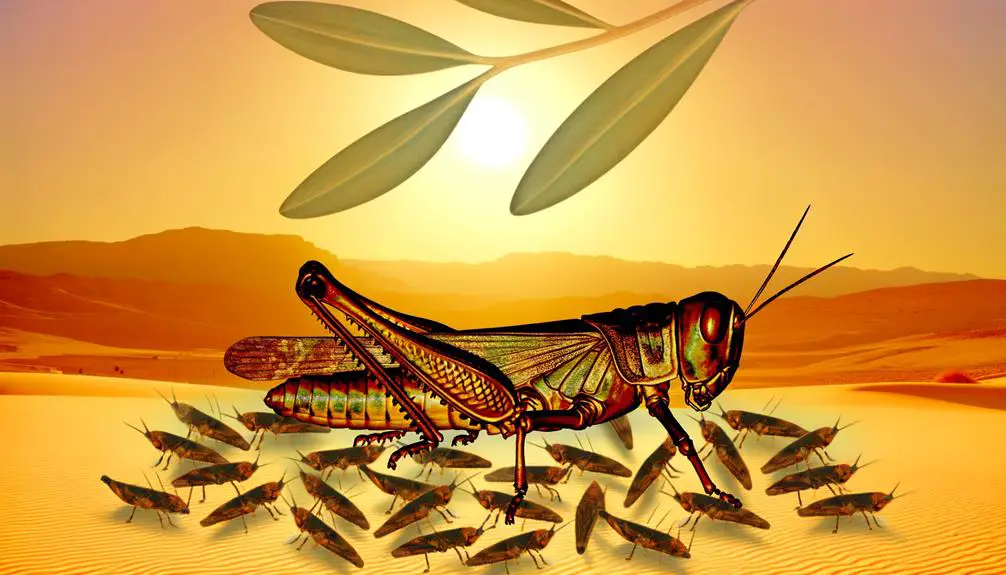
In biblical texts, grasshoppers emerge as symbols of insignificance and vulnerability, reflecting humanity's humility before the divine. This symbolism resonates deeply within the cultural interpretations of ancient societies, where agriculture played a central role in everyday life. Grasshoppers, often seen as pests, had the power to devastate crops, thereby directly impacting the livelihoods and sustenance of entire communities. This agricultural impact fostered a perception of grasshoppers that transcended mere annoyance, embedding them into a broader theological and moral narrative.
You'll find that in the context of biblical literature, grasshoppers aren't just insects; they're a metaphor for the fragility of human existence in contrast to the omnipotence of God. This juxtaposition highlights the vast disparity between human strength and the forces of nature or the divine, underscoring our vulnerability and dependence on higher powers for mercy and sustenance.
Moreover, the cultural interpretations of grasshoppers in biblical times were shaped by the agricultural impacts they represented. In societies where one's daily bread was quite literally reaped from the fields, the potential for grasshoppers to bring about famine and despair was a palpable reality. This threat elevated them from a simple pest to a symbol of divine judgment or a test of faith, thereby intertwining their biological impact with spiritual significance.
Through this lens, the biblical depiction of grasshoppers offers a rich tapestry of meaning, from illustrating human humility to encapsulating the interplay between nature, culture, and spirituality. These stories serve as a reminder of the enduring power of symbols to convey complex ideas and emotions, bridging the gap between the tangible and the transcendental.
The Spies' Report
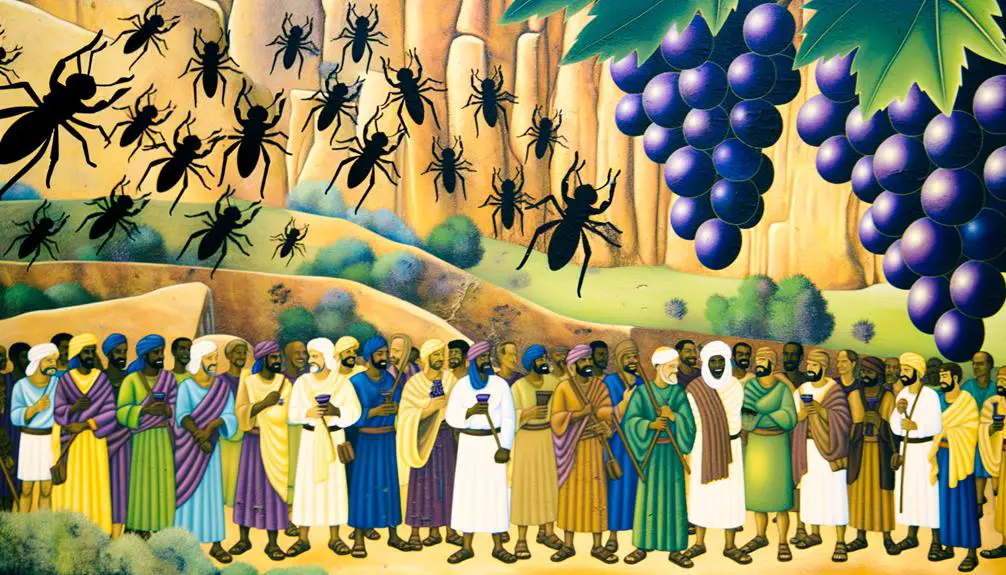
One of the most telling episodes involving grasshoppers in the Bible occurs when spies sent into Canaan describe themselves as 'grasshoppers' in the eyes of the giants inhabiting the land, symbolizing their own perceived vulnerability and insignificance. This metaphor not only captures their self-view but also highlights a pivotal moment in the land exploration narrative, where the perception of strength and size plays a crucial role in the psychological landscape of the explorers.
- Land Exploration Context: The mission into Canaan wasn't merely a physical journey but a test of faith and perception. The land, described as flowing with milk and honey, posed a formidable challenge, not just because of its inhabitants but because it forced the Israelites to confront their own fears and insecurities.
- Giant Perception: The description of the inhabitants as 'giants' to the spies' 'grasshoppers' illustrates a profound disparity in perceived power. This metaphor extends beyond physical size, delving into the psychological impact of facing seemingly insurmountable odds.
- Symbolic Significance: The grasshopper metaphor serves as a poignant reminder of how self-perception can shape one's reality. It's a narrative device that underscores the theme of faith versus fear, a common thread throughout the biblical text.
In examining this episode, you're not just looking at a historical recount of land exploration but a deeper exploration of human psychology. How the spies viewed themselves in relation to their challenges speaks volumes about the human condition, illustrating how one's perception of obstacles can dwarf their faith and courage. This story, therefore, isn't just about physical exploration but an introspective journey into understanding our own giants and grasshoppers within.
Portrayal of Fear and Weakness
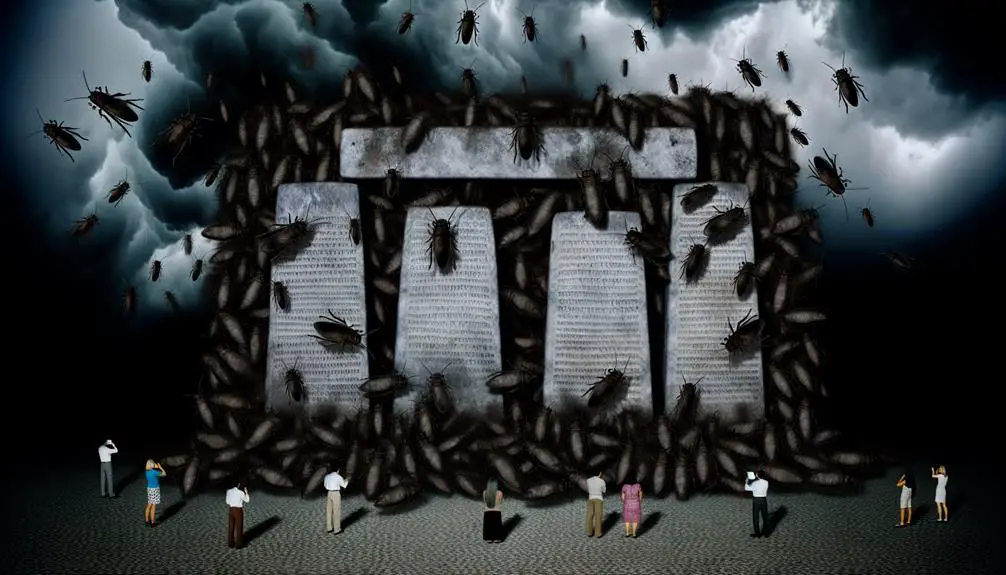
ARTICLE TITLE: Grasshoppers in the Bible
PREVIOUS SUBTOPIC: 'The Spies' Report'
CURRENT SUBTOPIC: 'Portrayal of Fear and Weakness'
Through the lens of biblical narratives, the portrayal of fear and weakness often reflects deeper psychological and spiritual battles individuals face when confronted with daunting challenges. Insect imagery, particularly that of grasshoppers, serves as a potent metaphor for such internal struggles. This symbolism is not arbitrary but steeped in cultural interpretations that add layers of meaning to the biblical text.
Aspect |
Insight |
|---|---|
Metaphor of Grasshoppers |
Demonstrates how individuals perceive their own insignificance in the face of overwhelming adversity. |
Psychological Battle |
Highlights the internal conflict between faith and fear, urging readers to reflect on their own spiritual resilience. |
Cultural Interpretations |
Provides context, showing how ancient societies viewed insects and their metaphorical significance in literature. |
Spiritual Implications |
Encourages a deeper understanding of one's faith and the power of perspective in overcoming feelings of inadequacy. |
You'll find that the use of grasshoppers to represent fear and weakness isn't just an arbitrary choice. It's deeply rooted in how cultures have historically perceived these insects – often as nuisances or signs of plague, which in turn colors their metaphorical use in scripture. This dual layer of representation – both the physical insignificance and the spiritual challenge it symbolizes – offers a rich field for analysis. It invites you to delve into the biblical text, understanding the complexities of human emotion and the ever-present challenge of maintaining faith in the face of daunting obstacles.
Messages of Divine Wrath
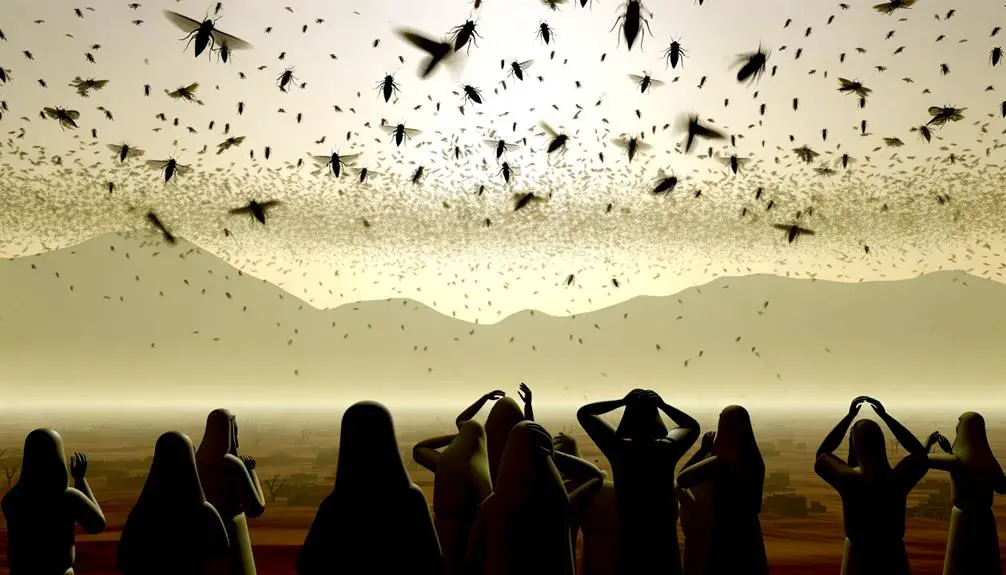
In the biblical context, you'll find that the plague of locusts isn't merely a natural disaster, but a profound message of divine wrath. This symbolism extends to judgment upon nations and peoples, calling them towards repentance and promising recovery if they turn back to divine teachings.
Analyzing these narratives, you gain insights into the complex relationship between divine wrath, human behavior, and the potential for renewal.
Plague of Locusts
Exploring the Plague of Locusts reveals its role as a powerful message of divine wrath in biblical narratives, underscoring the consequences of human disobedience and divine judgment. This biblical event symbolizes not just a natural disaster but a deliberate act of divine retribution, aiming to bring societies back to moral and spiritual alignment.
- Locust recipes: Historical accounts suggest that communities adapted to these plagues by incorporating locusts into their diets, showcasing resilience and adaptability.
- Agricultural impacts: The swarms devastated crops, leading to famine and economic turmoil, highlighting the vulnerability of human sustenance to divine will.
- Divine communication: The plague served as a stark reminder of the covenant between the divine and humanity, with disobedience resulting in tangible, severe consequences.
This analysis underscores the multifaceted nature of divine messages in biblical texts, where natural phenomena intertwine with spiritual lessons.
Symbolic Judgment
Divine wrath in the biblical narrative often manifests as symbolic judgment, reflecting the consequences of human actions against divine directives. This portrayal isn't just metaphorical but carries tangible effects, particularly seen through economic impact and agricultural disruption.
When you delve into these accounts, it's evident that the locusts aren't merely insects; they're instruments of a larger divine message. Their arrival decimates crops, leading to famine and economic instability, a direct consequence of humanity's misdeeds. This economic impact is profound, upending societies and highlighting the precarious balance between human action and divine will.
Thus, agricultural disruption serves as a physical manifestation of spiritual admonishment, urging a reflection on moral and ethical conduct in alignment with divine expectations.
Repentance and Recovery
Amidst the desolation brought by divine wrath, the biblical narrative unfolds a path for repentance and recovery, urging societies to realign with divine mandates. This journey towards restoration emphasizes the importance of humility, introspection, and a sincere commitment to change. Central to this process are:
- Forgiveness themes: Highlighting the possibility of divine pardon upon genuine repentance.
- Collective introspection: Encouraging communities to reflect on their actions and their impacts on societal harmony.
- Recovery strategies: Outlining practical steps for rebuilding and healing, underscored by faith and adherence to divine principles.
This scholarly exploration reveals that even in the face of divine wrath, the Bible offers a blueprint for recovery, underscoring the enduring power of forgiveness and the potential for societal transformation.
Instances of Resilience
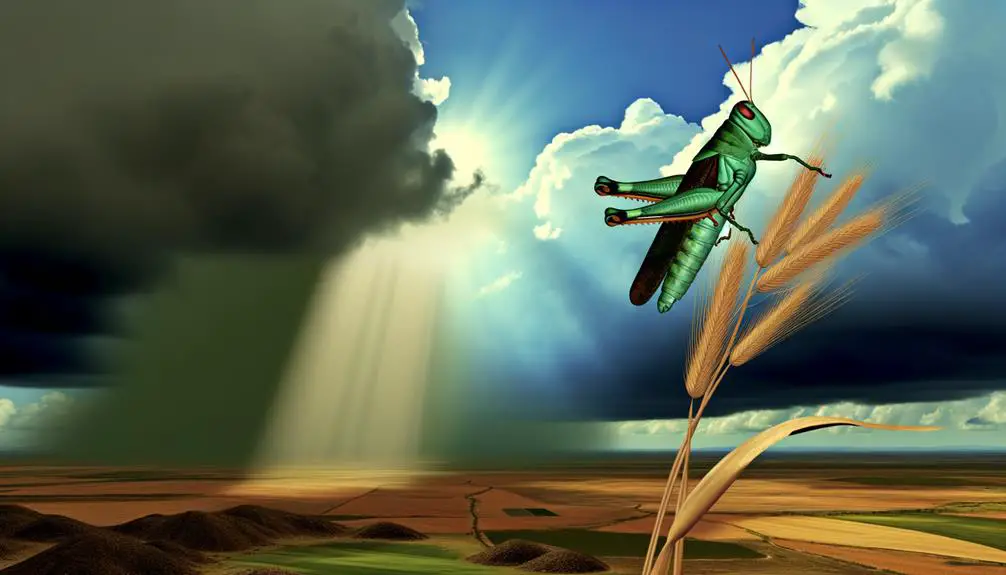
Throughout biblical narratives, grasshoppers serve as symbols of resilience, illustrating how, despite their small size, they persevere through challenges. This imagery resonates deeply within cultural interpretations, where grasshoppers are often seen as embodiments of strength and adaptability. Historically, these creatures have been pivotal in agricultural contexts, sometimes as pests causing significant impacts, yet their ability to thrive in diverse environments speaks to their resilience. This duality offers a rich tapestry for understanding the nuanced lessons embedded within biblical references to grasshoppers.
Analyzing the resilience of grasshoppers in the Bible requires a contextual understanding of their role in agricultural societies. Their presence in fields, while at times detrimental, also underscored the importance of adaptability and preparedness for the farmers. This mirrors the biblical message of enduring faith and perseverance in the face of adversity. The agricultural impacts of grasshoppers, therefore, provide a backdrop for interpreting their symbolic representation in scripture.
Moreover, cultural interpretations of grasshoppers in biblical times often underscored their resilience as a virtue. This perspective is crucial for a comprehensive understanding of their biblical significance. It's not just about their physical presence, but what they represent in the broader narrative of survival and adaptation.
In this light, grasshoppers in the Bible exemplify resilience, serving as a metaphor for enduring challenges with grace and strength. Their small stature belies their significant symbolic weight, offering profound insights into the human condition and the virtues of perseverance.
Lessons From Nature
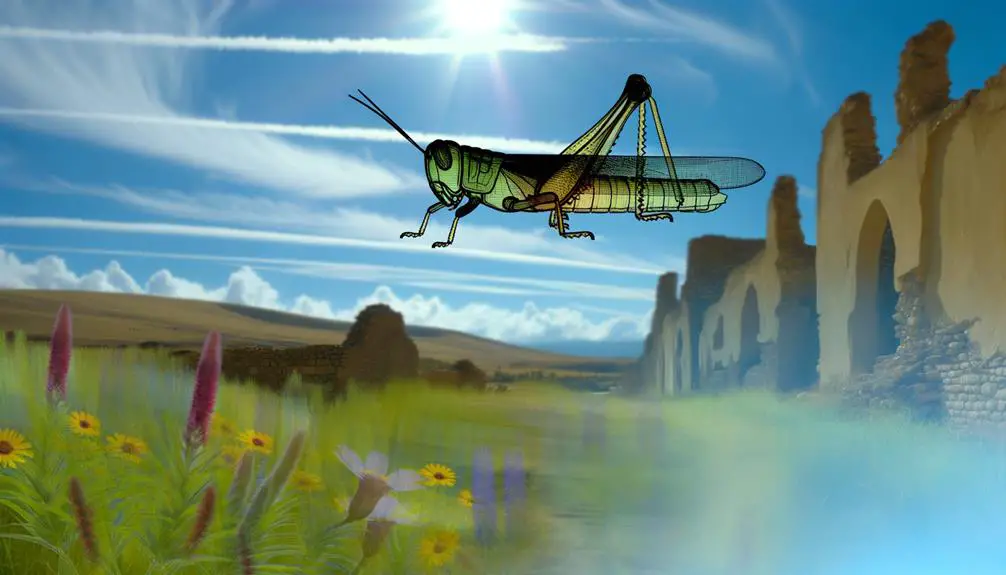
You'll observe that nature, as depicted in biblical narratives, serves as a conduit for divine messages, highlighting the interconnectedness of all creation.
The humble grasshopper, often overlooked, symbolizes a profound lesson in humility, reminding us of our own place within the vast tapestry of life.
This analysis underscores the importance of heeding the lessons embedded in nature, which, when interpreted through a scholarly lens, enrich our understanding of spiritual texts and our own existence.
Nature's Divine Messages
Nature's divine messages, encapsulated within the behavior and symbolism of grasshoppers in biblical texts, offer profound lessons on resilience and adaptability. These creatures, often overlooked, carry with them not just ecological significance but also spiritual interpretations that resonate deeply within the framework of biblical teachings.
- Ecological Harmony: Grasshoppers remind you of the delicate balance in nature, urging a respect for all creatures as part of a divinely orchestrated ecosystem.
- Spiritual Interpretations: Their presence in scripture symbolizes both a challenge and a promise, encouraging you to view life's obstacles through a lens of faith and perseverance.
- Resilience and Adaptability: Just as grasshoppers navigate their environments with ease, you're called to embrace change and uncertainty with grace, learning to thrive in varied circumstances.
These lessons, deeply embedded in nature, offer a rich tapestry of insights for reflection and growth.
Humility Through Creation
Building on the understanding of resilience and adaptability inspired by grasshoppers, let's explore how the natural world teaches us humility. Creation's lessons often stem from the most unassuming sources, urging you to look beyond the surface.
When you observe the intricate details of a grasshopper's life, it's a reflection of the broader ecosystem's complexity and balance. This insight nudges you towards recognizing your place within this vast creation, emphasizing the importance of humble beginnings.
It's through acknowledging the seemingly insignificant creatures and their roles that you're reminded of your own limitations and the collective strength found in diversity. Thus, nature, in its silent wisdom, cultivates a deep-seated humility in you, fostering a respect for all forms of life and their interconnectedness.
Frequently Asked Questions
How Do Modern Interpretations of Biblical Texts Reconcile the Ecological Impact of Locusts With Their Symbolic Meanings?
You're navigating how modern interpretations reconcile locust symbolism with their ecological impact. Scholars dive deep, analyzing texts to understand this balance. They argue that ecological reconciliation involves seeing locusts not just as destructive forces but as part of a larger, divine plan.
This perspective enriches our understanding, linking environmental realities with profound symbolic meanings. It's a nuanced approach, blending respect for nature with insights into ancient wisdom, offering a holistic view of these creatures' roles.
Are There Any Traditional Dishes or Practices That Involve Grasshoppers Stemming From Biblical Times?
You're exploring whether traditional dishes or practices involving grasshoppers have roots in ancient times, sans biblical context. Analyzing grasshopper symbolism and culinary traditions reveals a rich tapestry of cultural significance.
These insects have been both a source of sustenance and a symbol in various societies. Delving into historical records, you'll find that grasshoppers have played key roles in diets and rituals, showcasing their enduring impact beyond mere pests to culinary and symbolic elements.
How Have Different Cultures Around the World Interpreted the Biblical References to Grasshoppers Differently?
You'll find that cultures worldwide have uniquely interpreted the symbolism of grasshoppers, drawing on historical contexts and religious texts.
These interpretations vary significantly, influenced by local traditions and beliefs. For instance, some cultures might see grasshoppers as symbols of good fortune, while others view them as plagues or omens of change.
This divergence in cultural symbolism and historical interpretations reflects the rich tapestry of human belief systems and their evolutions over time.
In What Ways Have Artists and Musicians Been Inspired by the Biblical Stories Involving Grasshoppers?
Ironically, you'd think grasshoppers would leap out of the realm of artistic inspiration. Yet, artists and musicians have intricately woven these critters into their work.
Grasshopper sculptures and paintings delve deep into insect symbolism, exploring themes of resilience and transformation. This fascination isn't just a whimsical choice; it's a scholarly nod to their metaphorical weight in storytelling, showcasing how even the tiniest creatures can inspire profound reflections on the human condition.
Has Modern Entomology Provided Any Insights That Change Our Understanding of the Grasshoppers Mentioned in the Bible?
Modern entomology has provided new insights into grasshoppers through genetic analysis and climate correlation studies. These advances allow for a better understanding of the ecological and biological nuances of these insects. By analyzing their genetic makeup and correlating their behaviors with ancient climate patterns, a deeper, more scientifically enriched perspective on their role and symbolism emerges.
This new perspective might shift one's understanding of grasshoppers, moving beyond just biblical references to appreciate their significance in a broader context.
Conclusion
In analyzing the presence of grasshoppers in the Bible, it's evident that they're far more than mere insects; they embody deeply rooted symbolism and messaging. Particularly striking is their depiction in Numbers 13:33, where spies perceive themselves as grasshoppers in comparison to giants, illustrating profound lessons on perspective and faith.
Interestingly, despite their small size, grasshoppers can consume up to 60% of their body weight daily, paralleling the biblical messages of impact and resilience despite perceived insignificance. This statistic not only adds depth but also underscores the intricate layers of symbolism grasshoppers carry within biblical narratives, challenging readers to look beyond the surface.



Sign up